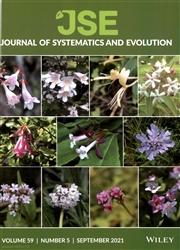用系统发生组学的方法厘清庞大而多样的菊科植物 Anthemideae(菊科)的进化过程
IF 2.9
1区 生物学
Q1 Agricultural and Biological Sciences
引用次数: 0
摘要
雏菊科 Anthemideae Cass.是菊科中规模最大、种类最多的科之一。我们使用一种有针对性的高通量测序方法分析了数据集,其中包括 111 个 Anthemideae 属中的 61 个,以及目前公认的 19 个亚支系(Inulantherinae、Lapidophorinae、Lonadinae 和 Vogtiinae)中除 4 个以外的所有支系。我们采用了不同的系统发生组学方法,利用核数据和质粒数据以及其他分析方法来估算分化时间和分化率,从而揭示了该族的进化历史和分类。我们的研究结果加强了以往研究中提出的抗风草科的系统发育主干,并进一步揭示了古代杂交事件、质体捕获和/或不完全世系分类(ILS)的可能发生,表明复杂的进化过程在该科的进化中发挥了重要作用。研究结果还支持将 Physmasperminae 亚支并入 Athanasiinae,将 Matricariinae 亚支并入 Anthemidinae,并澄清了之前尚未解决的关系。此外,该研究还通过确定三个主要类群:南部非洲类群、亚洲类群和环地中海类群,对该族的生物地理格局提供了更多的见解。这些类群与之前确定的类群部分吻合。总之,这项研究让人们对抗风草属植物有了更详细的了解,并改进了其分类方法。该研究还强调了系统发生组学方法对解读大型和多样化植物系进化动态的重要性。本文章由计算机程序翻译,如有差异,请以英文原文为准。
A phylogenomic approach to disentangling the evolution of the large and diverse daisy tribe Anthemideae (Asteraceae)
The daisy tribe Anthemideae Cass. is one of the largest and most diverse tribes within Asteraceae. We analyzed a data set including 61 out of 111 Anthemideae genera, and all but four of the 19 currently recognized subtribes (Inulantherinae, Lapidophorinae, Lonadinae, and Vogtiinae) using a targeted high‐throughput sequencing approach, the first focused on the tribe. We followed different phylogenomic approaches, using nuclear and plastid data, as well as additional analytical methods to estimate divergence times and diversification rates, to unravel the evolutionary history and classification of this tribe. Our results reinforce the phylogenetic backbone of the Anthemideae advanced in previous studies and further reveal the possible occurrence of ancient hybridization events, plastid capture, and/or incomplete lineage sorting (ILS), suggesting that complex evolutionary processes have played an important role in the evolution of this tribe. The results also support the merging of subtribe Physmasperminae into Athanasiinae and subtribe Matricariinae into Anthemidinae and clarify previously unresolved relationships. Furthermore, the study provides additional insights into the biogeographic patterns within the tribe by identifying three main groups: the Southern African Grade, the Asian Clade, and the circum‐Mediterranean Clade. These groups partially coincide with previously identified ones. Overall, this research provides a more detailed understanding of the Anthemideae tribe and improves its classification. The study also emphasizes the importance of phylogenomic approaches for deciphering the evolutionary dynamics of large and diverse plant lineages.
求助全文
通过发布文献求助,成功后即可免费获取论文全文。
去求助
来源期刊

Journal of Systematics and Evolution
Agricultural and Biological Sciences-Ecology, Evolution, Behavior and Systematics
CiteScore
7.40
自引率
8.10%
发文量
1368
审稿时长
6-12 weeks
期刊介绍:
Journal of Systematics and Evolution (JSE, since 2008; formerly Acta Phytotaxonomica Sinica) is a plant-based international journal newly dedicated to the description and understanding of the biological diversity. It covers: description of new taxa, monographic revision, phylogenetics, molecular evolution and genome evolution, evolutionary developmental biology, evolutionary ecology, population biology, conservation biology, biogeography, paleobiology, evolutionary theories, and related subjects.
 求助内容:
求助内容: 应助结果提醒方式:
应助结果提醒方式:


